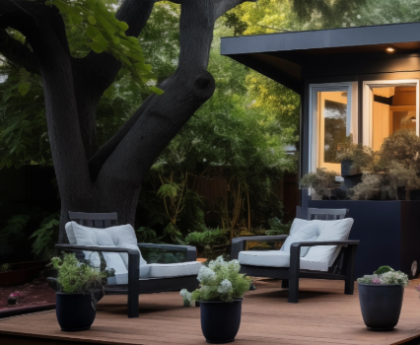When is an accessory dwelling unit (ADU) so big that it is not considered accessory anymore?
Members of the city’s Preservation Commission recently wrestled with that question.
In a 4-2 vote with one abstention, the commission agreed at its June 11 meeting to grant a homeowner’s request to demolish a frame garage behind the primary residence at 1525 Judson Ave. and put up a two-story structure in the property’s rear yard, where the family’s grandparents can live.
Still, some members of the group, which holds final authority in such cases, expressed concerns about this particular ADU even while voting in support.
“I have a feeling this is kind of an interesting test case for ADUs, particularly if the ordinance is written that they are clearly auxiliary buildings,” Commissioner Stuart Cohen said at the start of the June 11 discussion.
2020 ADU ordinance
Evanston approved a full-fledged ADU ordinance in 2020, responding to strong urging from the affordable housing community that ADUs – sometimes referred to as coach houses or granny flats – can provide an important source of housing for less affluent renters, the aging-in-place population and other residents.
Omar Salem, who is a member of the District 65 school board, and his wife, Stephanie, the owners of the Judson Avenue home, were looking to build an ADU to house his parents, a practice in line with how ADUs were viewed prior to 2018 legislation, which changed zoning law to allow non-family members to live in a coach house.
Evanston Development Cooperative helped open the door
The couple bought the property, a one-story Colonial Revival structure with a detached two-car garage, in October 2020.
They had already managed to persuade Omar’s parents to move back to Evanston to be closer to their grandchildren.
Beyond that, “Our plan at the time was kind of up in the air,” said Omar, speaking at the May 8 Preservation Commission meeting. “We thought maybe we would rebuild it, and we would put an addition on it [the existing structure]. We weren’t really sure.”
He said the idea for the ADU to replace the garage clicked for him after he connected with the Evanston Development Cooperative, a green construction co-op that specializes in ADUs.
“After talking with my folks, we realized that it was perfect for our family,” Salem told commissioners at their May meeting. “We knew that it would probably not be the most popular idea, so we wanted to make sure we didn’t ask for any variances or any zoning relief, [that] we conform to everything that’s required.”
The existing two-car garage was not suitable for conversion to a live-in unit because it had a thickened slab rather than a full foundation, which is required by the city’s building code to support a second floor, the couple wrote in their application.
The residence is located on the north central portion of the Lakeshore Historic District, occupying the southeast corner of Judson Avenue and Davis Street, City Planner Cade Sterling, who staffs the commission, said in a memo.
The Salems’ home, as well as homes immediately south and east, were constructed on the former estate of Hugh Wilson, a highly accomplished diplomat, according to Sterling. The estate was demolished in the late 1930s.
The Judson house was constructed in 1954 and the garage in 1956, Sterling’s research showed.
The proposed ADU with a garage for parking is 818 square feet, compared to the existing garage’s 450.66 square feet, Sterling determined. The house itself is 1,278 square feet.
At the June 11 meeting, the Salems’ architect, Anthony Hurtig, submitted revised drawings, responding to concerns raised by neighbors and some commissioners at their May meeting.
The revisions included moving the coach house slightly to the north, to distance it a little bit more from the line between the Salems’ property and the adjacent lot. They also reduced the height of the proposed structure by a foot.
The ADU, as planned, hits the maximum permitted under city code for both lot size and impervious surface, according to Sterling’s analysis.
“It is a very tight plan,” Hurtig told commissioners.
” data-image-caption=”
A proposed site plan submitted to the Preservation Commission by architect Anthony Hurtig.
” data-medium-file=”https://evanstonroundtable.com/wp-content/uploads/2024/06/Screenshot-2024-06-26-at-4.30.48 PM-300×191.jpg” data-large-file=”https://evanstonroundtable.com/wp-content/uploads/2024/06/Screenshot-2024-06-26-at-4.30.48 PM-1024×653.jpg” src=”https://evanstonroundtable.com/wp-content/uploads/2024/06/Screenshot-2024-06-26-at-4.30.48 PM-1024×653.jpg” alt class=”wp-image-367191″ srcset=”https://evanstonroundtable.com/wp-content/uploads/2024/06/Screenshot-2024-06-26-at-4.30.48 PM-1024×653.jpg 1024w, https://evanstonroundtable.com/wp-content/uploads/2024/06/Screenshot-2024-06-26-at-4.30.48 PM-300×191.jpg 300w, https://evanstonroundtable.com/wp-content/uploads/2024/06/Screenshot-2024-06-26-at-4.30.48 PM-768×490.jpg 768w, https://evanstonroundtable.com/wp-content/uploads/2024/06/Screenshot-2024-06-26-at-4.30.48 PM-1536×980.jpg 1536w, https://evanstonroundtable.com/wp-content/uploads/2024/06/Screenshot-2024-06-26-at-4.30.48 PM-1200×766.jpg 1200w, https://evanstonroundtable.com/wp-content/uploads/2024/06/Screenshot-2024-06-26-at-4.30.48 PM-1568×1000.jpg 1568w, https://evanstonroundtable.com/wp-content/uploads/2024/06/Screenshot-2024-06-26-at-4.30.48 PM-400×255.jpg 400w, https://evanstonroundtable.com/wp-content/uploads/2024/06/Screenshot-2024-06-26-at-4.30.48 PM-706×450.jpg 706w, https://evanstonroundtable.com/wp-content/uploads/2024/06/Screenshot-2024-06-26-at-4.30.48 PM.jpg 1856w” sizes=”(max-width: 1024px) 100vw, 1024px”>
Despite the adjustments, a number of the Salems’ closest neighbors still said it was too tight a fit during the June 11 commission meeting.
“I am shocked that anybody can build basically another residence on a lot that is extremely small,” said Thomas Breen, who’s lived at 1515 Judson Ave. for about 20 years. “This puts two homes on one of the smallest lots in the street.”
Light and air replaced with Hardie board
Donna Harrison, who lives at 1519 Judson, brought photographs mounted on a board with her to show the proposed ADU’s proximity to her property.
“Once you build up, even if it’s only to nine feet from eight feet, this will not be my view any longer out of my primary bathroom. The only window in that bathroom will be gone,” she said, referring to those pictures. “And those trees hang over the garage – they will have to be taken down to be able to put this structure up.”
Jeff Smith, an attorney for Donna and Mitchell Harrison, said one of the difficulties with the proposal has to do with the location of the backyard on the corner lot. Most backyards face an alley or away from the street, and they don’t typically back up directly to a house that faces the street, according to Smith.
The ordinance itself, he argued, “says you shouldn’t be locating it [the ADU] in an interior side yard.”
“What you’ve got here is an architectural anomaly from the 1950s that at the moment is not interfering with my clients’ quality of life. They get to have the light and air that zoning was intended to protect … and they look out their windows and see trees and sky and air,” Smith said about the existing structures.
“And that’s going to be replaced with what I would call Hardie board; I guess there are nice words for cement board cladding, and it’s got its utilities as a building material, but it’s not what you expect when you buy into this neighborhood in a preservation district.”
He suggested that the ADU should be added to the principal structure, instead. “What’s happening here is that the privacy of my clients is going to be sacrificed so that the privacy of an interior patio can be observed,” he maintained.
Class and race helped stoke the need for ADUs
In her testimony, Stephanie Salem spoke about some of the factors that led to the need for ADUs in the first place.
Doing research on the sale of her own grandparents’ home in north Evanston, Stephanie told commissioners that she had become more familiar with the commission’s role and the city’s historic preservation process.
“There is an element of sensitivity in consideration that I feel like is missing on some occasions. While there are many great things about seeing and preserving history, it is also important to recognize how some of those things came to be,” she said.
“Class and race heavily played a role in the development and redevelopment of certain parts of Evanston. So, for example, a reason coach houses were traditionally at the back of properties is because that’s where the workers, and not the homeowners, resided. And that practice makes sense for some properties at some times, but it does not make sense for all.”
She referred to a 2022 RoundTable article about the commission seeking to reach more people, “to be accessible to different families and their projects and make their process as approachable and clear as possible.”
“I think as the Evanston community continues to evolve, that is a great and ambitious goal,” she said. “But I also think there’s still work to be done to make that as accessible to everyone as possible.”
‘A second house … masquerading as an ADU’
The commissioners, meanwhile, focused on two standards of concern in their final deliberation: the effect of the ADU on the rhythm of spacing and structures on the street, and the scale of the structure.
“The thing about this project is that, while it conforms to the letter of the law, it so blatantly is not in the spirit of the law,” said Cohen, leading off the discussion. “The reason I say that is, if you look at the footprint of the street, the volume of the main house and the volume of the ADU are approximately the same.”
Commission member Carl Klein added that this site is “difficult” for building something like the proposed ADU, and that he was “struggling with the fact that this is essentially building a second house on the lot that is masquerading as an ADU.”
Lesa Rizzolo, another commissioner, offered a different point of view, noting that she herself lives “in a rather large coach house” backing up to her neighbors, and that “there are homes like this in the district.”
Commission Chair Sarah M. Dreller said she had more of an issue with the scale of the ADU, rather than the spacing, and that when she walked the site, “I was impressed by how close the buildings [on the block] are to each other.”
” data-image-caption=”
A rendering of the proposed site by architect Anthony Hurtig.
” data-medium-file=”https://evanstonroundtable.com/wp-content/uploads/2024/06/Screenshot-2024-06-26-at-4.30.38 PM-300×227.jpg” data-large-file=”https://evanstonroundtable.com/wp-content/uploads/2024/06/Screenshot-2024-06-26-at-4.30.38 PM-1024×776.jpg” src=”https://evanstonroundtable.com/wp-content/uploads/2024/06/Screenshot-2024-06-26-at-4.30.38 PM-1024×776.jpg” alt=”An architectural rendering of the home at 1525 Judson Ave. and a proposed accessory dwelling unit that would replace the existing garage.” class=”wp-image-367190″ srcset=”https://evanstonroundtable.com/wp-content/uploads/2024/06/Screenshot-2024-06-26-at-4.30.38 PM-1024×776.jpg 1024w, https://evanstonroundtable.com/wp-content/uploads/2024/06/Screenshot-2024-06-26-at-4.30.38 PM-300×227.jpg 300w, https://evanstonroundtable.com/wp-content/uploads/2024/06/Screenshot-2024-06-26-at-4.30.38 PM-768×582.jpg 768w, https://evanstonroundtable.com/wp-content/uploads/2024/06/Screenshot-2024-06-26-at-4.30.38 PM-1200×909.jpg 1200w, https://evanstonroundtable.com/wp-content/uploads/2024/06/Screenshot-2024-06-26-at-4.30.38 PM-400×303.jpg 400w, https://evanstonroundtable.com/wp-content/uploads/2024/06/Screenshot-2024-06-26-at-4.30.38 PM-706×535.jpg 706w, https://evanstonroundtable.com/wp-content/uploads/2024/06/Screenshot-2024-06-26-at-4.30.38 PM.jpg 1238w” sizes=”(max-width: 1024px) 100vw, 1024px”>
In the proposed project, she said, there is “actually more space between the proposed ADU and the neighbor’s house than the other houses that are there.” On the other hand, she added, “I am also struggling with the scale of this as it compares to the main house.”
Cohen pointed out that, if the commission was viewing the proposed ADU as a new house, it is “absolutely in scale with the house to its north and even the house to the other side.
“So, while I sympathize with the neighbors,” he said, “it’s sort of like I feel I’m between a rock and a hard place, because I really feel that if we’re faced with the criteria for Certificate of Appropriateness, architecturally, it’s a pretty decent looking thing, and it seems to meet them.”
Unlike most city boards and commissions, the Preservation Commission is the determining body on issues before it, rather than the City Council. Members ultimately voted 4-2-1 in support of the homeowners request, with Dreller and Klein voting against, and Beth Bodan abstaining.



